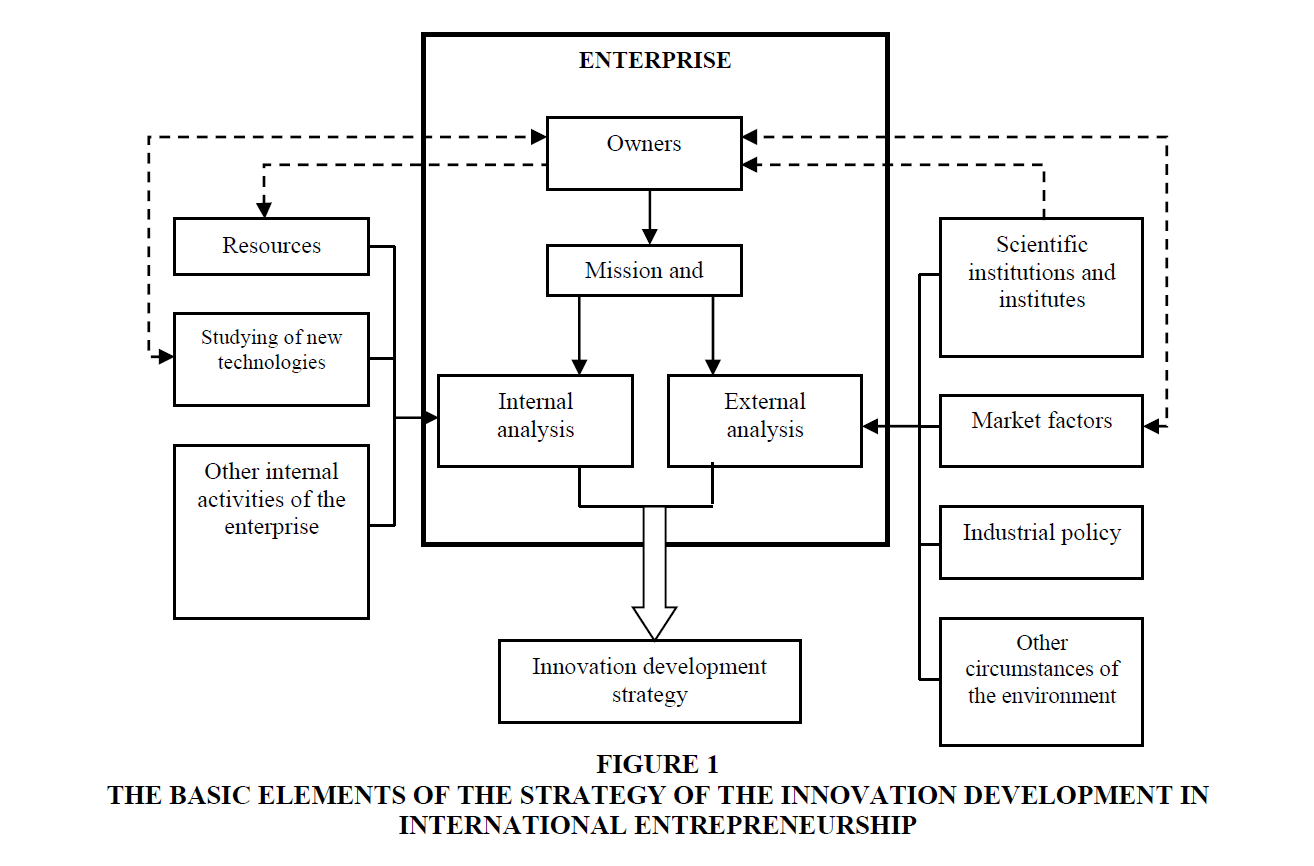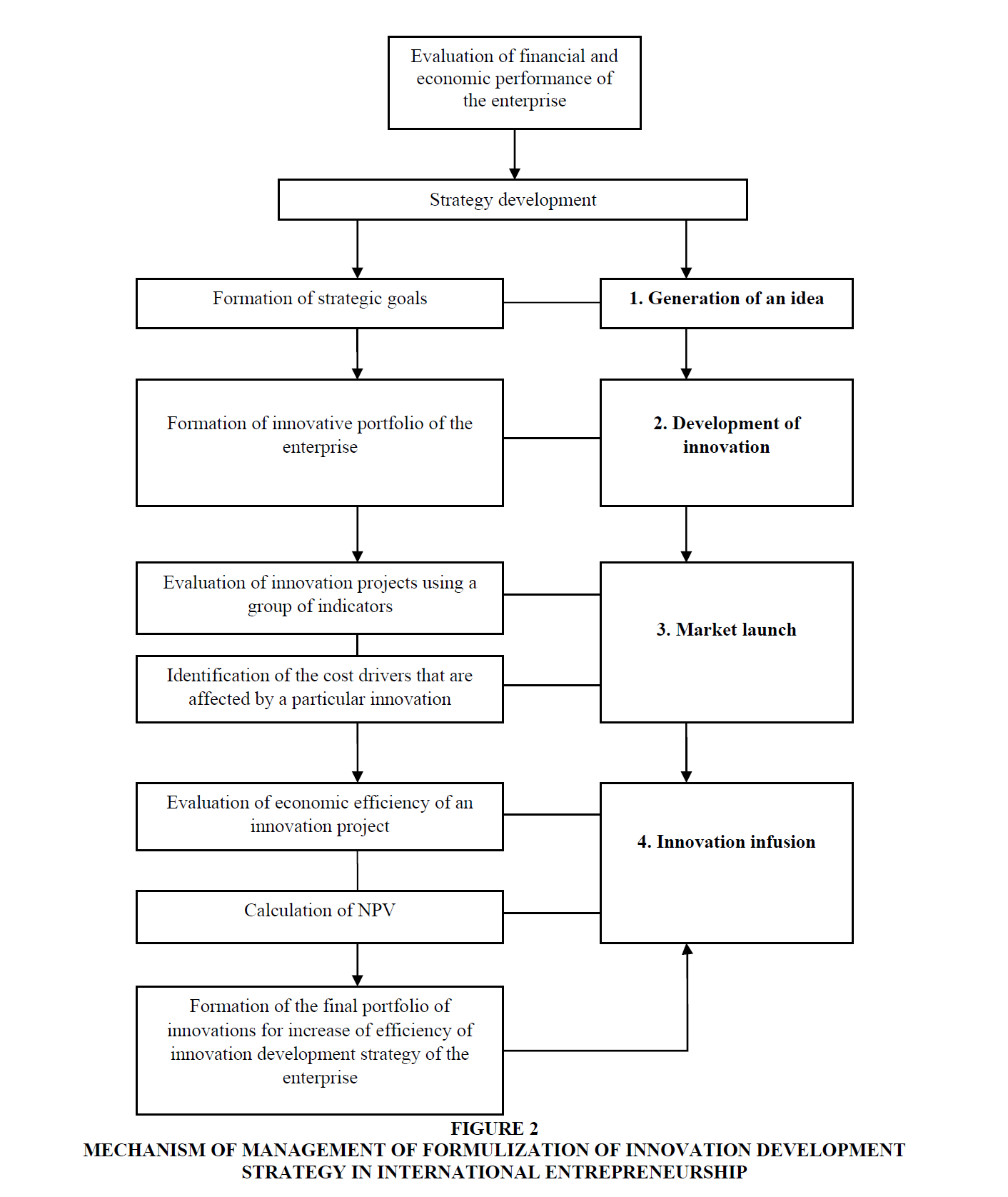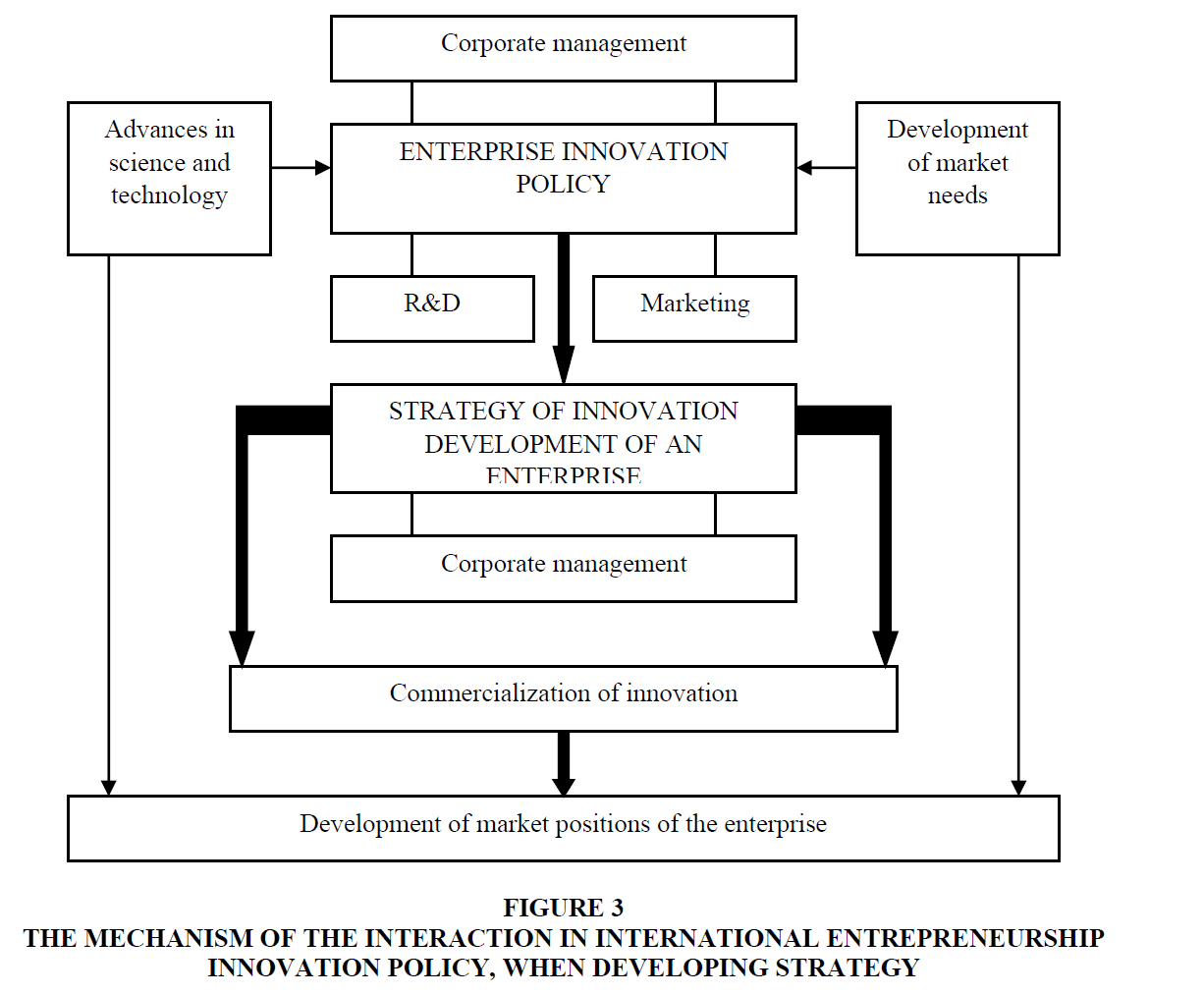Research Article: 2020 Vol: 24 Issue: 1S
Features of Application of Innovative Development Strategies in International Enterprise
Akmal Durmanov, Tashkent Institute of Irrigation and Agricultural Mechanization Engineers, Uzbekistan
Nikolay Kalinin, Plekhanov Russian University of Economics, Russia
Svetlana Drobyazko, European academy of sciences, United Kingdom
Kateryna Yanishevska, Sumy State University, Ukraine
Inga Shapovalova, Open International University, Ukraine
Abstract
The issues of supporting the development of an innovative development strategy in the system of international entrepreneurship, provides a thorough description of the management models for developing an innovative development strategy in the framework of the growth directions of international entrepreneurship potential are investigated in the article. The components of the strategy for innovative development of entrepreneurship are determined. The mechanism for the interaction of innovation policy in entrepreneurial activity when developing a strategy is proposed. The management sequence of the formation of innovation policy in the system of international entrepreneurship in the form of logical and structural stages is highlighted.
Keywords
International Entrepreneurship, Enterprise, Innovation Development Strategy, Enterprise Potential, Innovation Product.
Introduction
The close relationship between the innovation vector of development and complex long-term strategy steadily become the leading trend of the modern innovation policy in international entrepreneurships on the way of increase of their potential. This situation is explained by that the innovations and strategy of the innovation development are forwarding factors of the market competitiveness and stability. From the point of view of the theoretical-and-methodological provisions of the strategical management, the innovation strategies belong to the group of the functional strategies of the enterprise, and in this case innovations at the enterprise are not the main factor of development, but a component of the strategic field, both as an element and as a leading factor. Although, the characteristic feature of the strategic management theory is the combination of the strategic and innovation aspects in the enterprise activities. We beleive that the innovations should determine the leading prospectives of the improvement of the competitive positions of the enterprise, and the innovation development strategies should be a framework for such changes.
Methodology
The innovation development of enterprises in the coordinates of the strategical management is expedient to be considered as a complex of strategies, measures, methods and approaches of achievement of goals of the innovation activities, which will allow to implement them to the maximum possible extent taking into account the interests of the specific enterprise. The selection of the rational strategies and priorities in the development of the innovation activities of the enterprise forms the processes of introduction of the critical technologies and innovation projects, which have the crusial influence on the increase of the level of effectiveness of the production and competitiveness of the products.
In the framework of our research, we propose the following levels of development of a strategy for innovation development in international entrepreneurship (Figure 1), which forms the dialectical belt of mutual influence and penetration of the components of its internal and external environment.
Figure 1:The Basic Elements Of The Strategy Of The Innovation Development In International Entrepreneurship.
Literature Review
The applied studies aimed at the improvement of the toolkit of the innovation activities were conducted by: Ahlstrom (2010); Bock et al. (2010); Eagar et al. (2011); Kim & Park (2010); Tetiana et al. (2018); Theodore (2014). The issues of the strategical development of the innovation positions of enterprises found their reflection in the papers of the following scientists: Bryson (2004); Strand (2014); Suh (2010); Drobyazko et al. (2019 a, b); Durmanov et al. (2019); Metelenko et al. (2019). The aim of the study is the development of the theoretical and methodological principles of management of the strategic innovation development in the environment of industrial enterprises.
Findings and Disussions
The presented model is intended to transform the goals and objectives of the innovative development of the enterprise, which naturally give corresponding results based on its concept. The very concept of the strategy of innovation development of the enterprise should be a basic part of the general concept of development and define the goals, objectives, principles and areas of innovation development. A critical analysis of the scientific papers of Baumgartner and Ebner (2010) and comparison of models of management of the formulization of innovation development strategy gives us an opportunity to distinguish the following varieties:
The rationalist model is based on the full awareness and conscious interest of the enterprise management in breakthrough innovative activities and projects. In doing so, we introduce the assumption that enterprise management will take alpha-participation in the development, implementation and evaluation of these innovative measures, provision of systematic control, and formation of reporting and adjustment points. Such a model should include transparent procedures for making managerial decisions, their actual and rapid implementation, linear control and maintenance of an effective system of organizational and managerial communications with a minimum of "noises" and bifurcation of information flows. The fundamental shortcomings of the rationalistic model can include the possibility of creation of a “stratification” of the actual parametric field of innovation and planning, which is caused by a mismatch in the strategic management system and possible defects in the internal control system.
The behavioural model for management of the formulization of an innovation development strategy includes an aspect of the primary consideration of the social and psychological needs of the enterprise staff in the development and implementation of stages of the innovation development strategy. In this model, we can consider the enterprise as a self-organizing system, which includes: 1) the aspect of decentralization in making management decisions at all levels of enterprise management; 2) the concentration factor of organizational activity at the level of departments and project groups (if any); 3) pluralism of definition and adjustment of strategic goals of industrial enterprise development.
The system model of management of innovation development strategies defines the enterprise as a "techno-social system", within which the development of such strategies and the project innovation itself can be realized not in a circle of certain conditions, but as a vectorized process based on preliminary analysis of organizational problems and search for solutions in the organization of innovation development strategy. The particular attention is paid to the objects of the strategy, not to the subjects (individuals). The disadvantages include the autonomy of the production activity of individual workers within the framework of innovation development measures (Germeraad, 2010). On the basis of analytical research of models of management of formulization of innovation development strategy, we can construct a summary table of their comparison (Table 1).
| Table 1: Comparison Of Models Of Management Of Formulization Of Innovation Development Strategy Within The Potential Of The Enterprise | |||
| No. | Model | Positive manifestations | Disadvantages |
|---|---|---|---|
| 1 | Rationalist | The existence of clear procedures of creation of innovation development strategy and strict control of their implementation. | Frequent mismatch of strategy of its real implementation. |
| An effective communication system. | Uncertainty in achieving results. | ||
| 2 | Behavioural | The corporation is regarded as the single self-organizing system. Broad discussion of strategic goals. | Sharing responsibility in the implementation of innovative development strategy |
| Orientation to the "human factor". | |||
| 3 | System | Preliminary analysis of organizational problems associated with strategy development. | Independent work of individuals involved in the formulization of innovative development strategies is not taken into account. |
Based on this theoretical basis, the authors propose the following organizational mechanism for management of the formulization of the innovation development strategy in international entrepreneurship, which is shown in Figure 2.
Figure 2:Mechanism Of Management Of Formulization Of Innovation Development Strategy In International Entrepreneurship.
This mechanism includes the main four stages of the innovation lifecycle: 1) Idea generation, 2) Innovation development (R&D enabled), 3) Market launch, 4) Innovation infusion. There are the necessary goals for each of these steps, the fulfillment of which will lead to the effective management of the formulization of the innovation development strategy in international entrepreneurship (Claggett & Eklund, 2005).
In this mechanism we propose to distinguish four leading main stages and one zero stage, in the form of "Estimation of financial and economic performance of the enterprise".
The formation of strategic goals of the strategy is performed at the stage of "Idea generation". The formation of an innovative portfolio in international entrepreneurship is performed at the stage of "Development of innovation"; An innovation portfolio is a set of real or financial expressions of innovations, a set of innovations in international entrepreneurship of different kind, and different duration and different degree of liquidity. At this stage, the index of high-tech activity in international entrepreneurship is taken into account. The “Market launch” stage involves evaluation of innovative projects using a set of indicators and identifying the cost drivers that are affected by a particular innovation.
The formation of strategic goals of the strategy is performed at the stage of "Idea generation". The formation of an innovative portfolio in international entrepreneurship is performed at the stage of "Development of innovation"; An innovation portfolio is a set of real or financial expressions of innovations, a set of innovations in international entrepreneurship of different kind, and different duration and different degree of liquidity. At this stage, the index of high-tech activity in international entrepreneurship is taken into account. The “Market launch” stage involves evaluation of innovative projects using a set of indicators and identifying the cost drivers that are affected by a particular innovation.
Further, it is advisable to present a more detailed model of formulization of the innovation development strategy in international entrepreneurship, which will show the whole process of interaction of all participants in the strategy development and the process of its commercialization. Before going into a detailed analysis of the formulization of the innovation development strategy in international entrepreneurship, we draw attention to the fact that the development process and the innovation development strategy itself is part of the innovation policy of industrial enterprise. So, the effective implementation of the goals and objectives of the innovation strategy depends on the innovation policy in international entrepreneurship. It, in turn, is part of the overall corporate policy that provides for the identification and selection of the most effective innovation development strategies and their timely implementation. Many authors have already researched this issue. When developing a strategy for innovative development in an industrial enterprise, innovation policy can be represented within three main elements: setting goals and objectives of the innovation development; development of effective methods and means of achieving the set goals, as well as the selection and placement of personnel capable of solving the tasks set before them.
In this regard, it is important that innovation development strategies that form the basis of industrial enterprise innovation policy meet a number of fundamental requirements, namely (Berkhout (2011), Soukhoroukova et al. (2012):
1. The innovation development is highly correlated with the mission and main purpose of the enterprise;
2. New technologies in functional areas of the enterprise should be aimed at organizational and economic result;
3. The reality of the timing of achievement of the planned parameters, taking into account the results of the SWOT-analysis of the external and internal environment of the enterprise;
4. Possibility of adjustment and managerial flexibility of parameters under the influence of changes of factors of the external and/or internal environment of the enterprise;
5. Consistency of the achieved and planned goals according to the strategic tool - “enterprise goal tree”.
On this basis, we can build a mechanism for the interaction of innovation policy in the development of a future strategy for innovation development for an industrial enterprise (Figure 3).
Figure 3:The Mechanism Of The Interaction In International Entrepreneurship Innovation Policy, When Developing Strategy.
The sequence of innovation policy formation in an industrial enterprise can be presented in the context of a number of stages:
The formation of a competitive and effective innovation policy for the long term aims at formulation of the real goals and objectives of innovation development and must coordinate its parameters with the overall corporate strategy.
The evaluation of the dynamics of innovation activity and the current state of innovation infrastructure at the enterprise. This stage creates a list of promising or modified production and maintenance technologies in terms of cost and payback of their implementation in the current infrastructure in international entrepreneurship. It is advisable to make an inventory of the R&D conducted in the cost-result coordinates, and to provide an outlook for the prospect of R&D in the system of tasks for innovation development strategy in international entrepreneurship (Teece, 2010).
The development of variants of implementation of innovation strategies and their coordination in coordinates "term of realization → resource base → executors" This stage is realized on the basis of perspective and justified alternatives of development and realization of multi-term innovative projects at the enterprise on the basis of flexibility of resource provision.
Recommendations
Assessment of the level of economic efficiency. Formation of a portfolio of innovative projects. The options for innovation development strategies identified at the fourth stage shall be converted into a specific form of business plans or innovation-investment projects. The project portfolio should be formed on the basis of qualitative criteria such as: life cycle of innovations, degree of commercial importance, terms of realization, necessary volumes of resources, and risk factors.
The control and analytical evaluation of deviations in the set and achieved strategic goals of innovative development. During the implementation of the strategy of innovation development, it is necessary to ensure not only its organizational and economic support, but also timely adjustment in case of significant changes in the market situation, lauching of similar products by competitors, emergence of new scientific knowledge, and changes in internal organizational and economic conditions at the enterprise.
Conclusion
So, within the framework of the conducted research, the theoretical and methodical basis of the formulization of the innovation development strategy in international entrepreneurship was formed, based on the study of its compliance with the corporate strategy. The factors and conditions of the innovation development of the enterprise were determined, the management of which allows to mobilize additional resources, improve the efficiency of internal flow management, as well as the quality of strategic and operational decisions at all levels of the enterprise with a priority orientation to the innovative type of development.
The use of a comprehensive approach to the formation of innovation development strategy was justified based on the alternative of achievement of the goals of innovation development of enterprises in the process of development and implementation of managerial decisions, taking into account unforeseen changes in internal and external factors.
References
- Ahlstrom, D. (2010). Innovation and growth: how business contributes to society. Academy of Management Perspectives, 24(3), 11-24.
- Berkhout, F. (2011). Eco-innovation: Reflections on an evolving research agenda. International Journal of Technology, Policy & Management, 11(3), 191-197.
- Bock, A.J., Opsahl, T., & George, G. (2010). Business model innovation and strategic flexibility: A study of the effects of informal and formal organization. Imperial College, London, United Kingdom.
- Bryson, J.M. (2004). Strategic planning for public and nonprofit organizations: A guide to strengthening and sustaining organizational achievement, 3rd edn, San Francisco, Jossey-Bass.
- Claggett, L., & Eklund, B. (2005). Create, organize and expedite a strategic plan: How to use the balanced scorecard and the stage-gate funnel. Information Outlook, 9(3), 21-31.
- Drobyazko, S., Barwinska-Malajowicz A., Slusarczyk B., Zavidna L., & Danylovych-Kropyvnytska M. (2019). Innovative entrepreneurship models in the management system of enterprise competitiveness. Journal of Entrepreneurship Education, 22(4), 2019.
- Drobyazko S., Okulich-Kazarin V., Rogovyi A., Goltvenko O., & Marova S. (2019). Factors of Influence on the Sustainable Development in the Strategy Management of Corporations. Academy of Strategic Management Journal, 18(1).
- Durmanov, A., Bartosova, V., Drobyazko, S., Melnyk, O., & Fillipov, V. (2019). Mechanism to ensure sustainable development of enterprises in the information space. Entrepreneurship and Sustainability Issues, 7(2), 1377-1386.
- Eagar, R., Van Oene, F., & Boultan, C. (2011). The future of innovation management. Prism, 1, 20-36.
- Germeraad, P. (2010). Integration of intellectual property strategy with innovation strategy. Research Technology Management, 53(3), 10-18.
- Hortinha, P., Lages, C., & Felipe, L. (2011). The trade-off between customer and technology orientations: Impact on Innovation capabilities and export performance. Journal of International Marketing, 19(3), 36-58.
- Karpenko, L., Serbov, M., Kwilinski, A., Makedon, V. & Drobyazko, S. (2018). Methodological platform of the control mechanism with the energy saving technologies. Academy of Strategic Management Journal, 17(5).
- Kim, C., & Park, Jong-Hun. (2010). The global research-and-development network and its effect on innovation. Journal of International Marketing, 18(4), 43-57.
- Metelenko, N.G., Kovalenko, O.V., Makedon, V., Merzhynskyi, Y.K., & Rudych, A.I. (2019). Infrastructure security of formation and development of sectoral corporate clusters. Journal of Security and Sustainability Issues, 9(1), 77-89. shttp://doi.org/10.9770/jssi.2019.9.1(7)
- Soukhoroukova, A,M. Spann., Skiera, B. (2012). Sourcing, filtering, and evaluating new product ideas an empirical exploration of the performance of idea markets. Journal of Product Innovation Management, 29(1), 100-112.
- Strand, R. (2014). Strategic leadership of corporate sustainability. Journal of Business Ethics, 123(4), 687-706.
- Suh, N.P. (2010). A theory of innovation and case study. International Journal of Innovation Management, 14 (5), 893-913.
- Teece, D.J. (2010). Business models, business strategy and innovation. Long Range Planning, 43(3), 172-194.
- Tetiana, H., Karpenko, L., Fedoruk, O., Shevchenko, I., & Drobyazko, S. (2018). Innovative methods of performance evaluation of energy efficiency project. Academy of Strategic Management Journal, 17(2), 112-110.
- Theodore, J. (2014). The necessity of strategic leadership in corporate sustainability. Journal of Sustainability Management, 2(1), 23-30.


